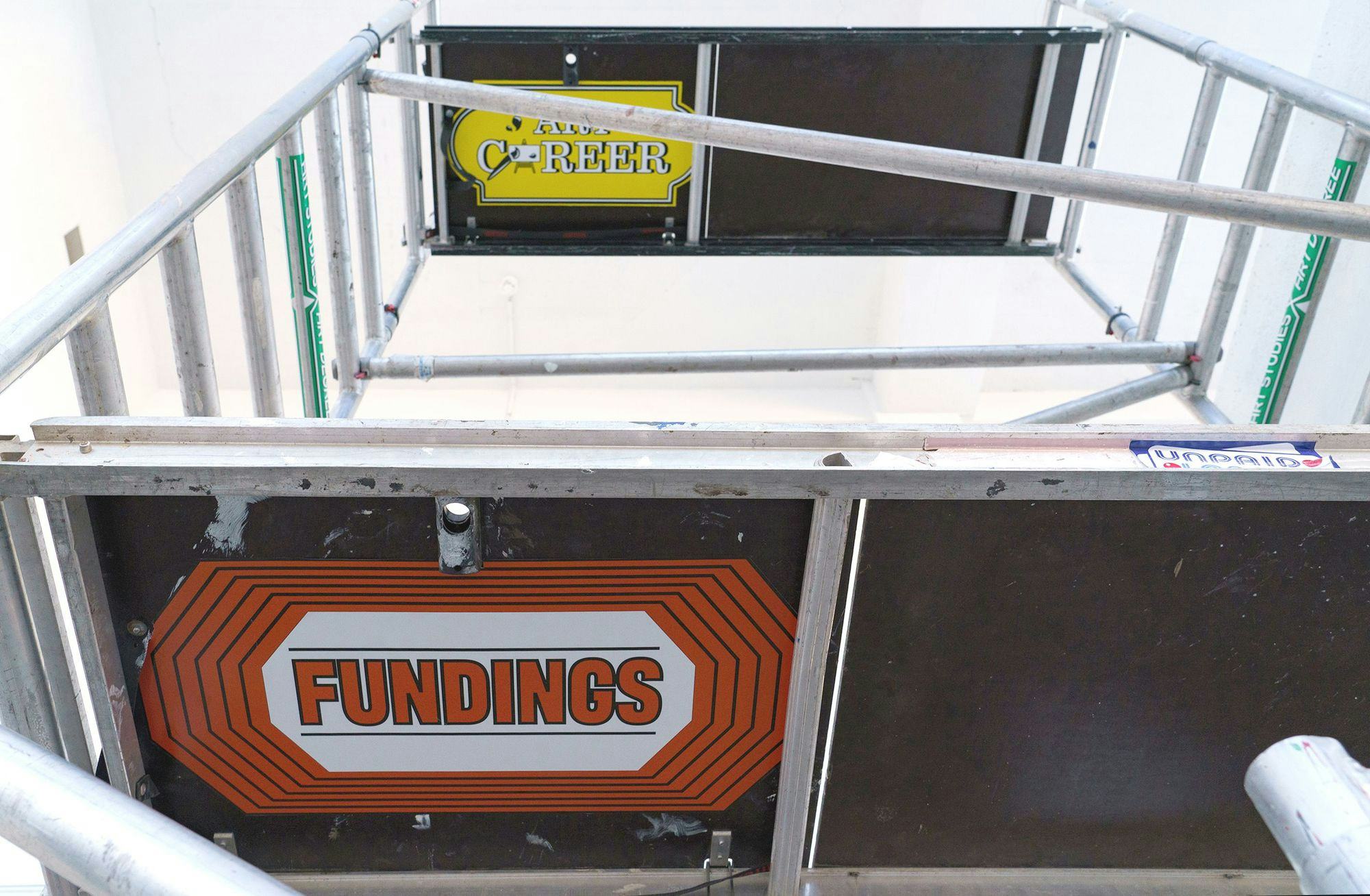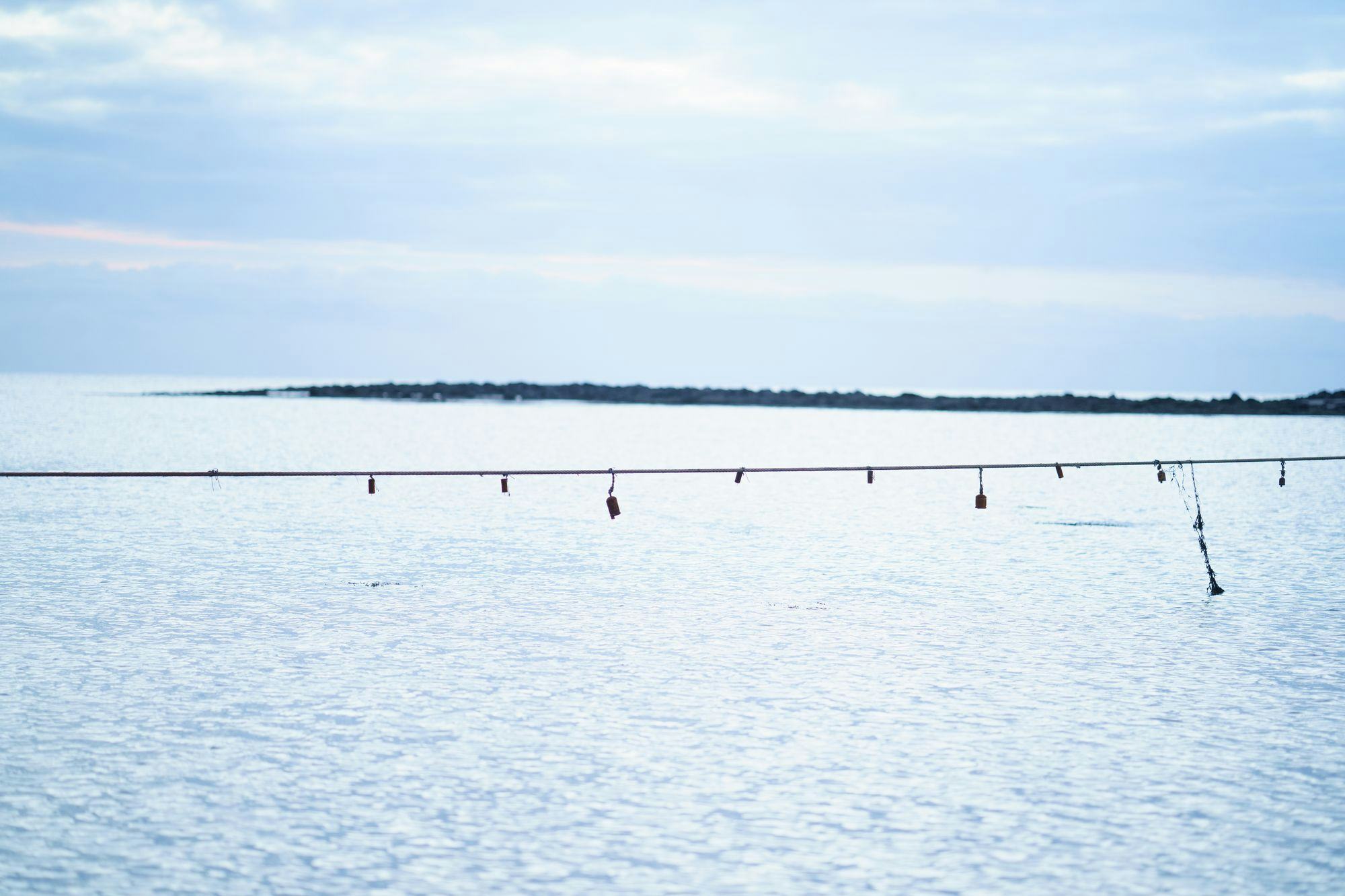If I had to use one adjective to describe the current Venice Biennale, I think I would choose the word refreshing. Don't get me wrong, the works are often very moving, as the main subject of this year's Bienniale is the struggle of many, different, marginalized groups. I use the word refreshing to describe my experience of this particular Biennale in the context of previous Biennales, and there are several reasons for that.
Foreigners Everywhere is the title of this year's festival, Stranieri Ovunque in Italian. The name comes from the work of an artist duo called Claire Fontaine who reused the phrase after coming across it in Turin. There, the words had been spray-painted on walls as a form of protest to the growing xenophobia in Italy at the beginning of this century.

Mataaho Collective's piece Takapau from 2022 stretches across the entire first hall of the Arsenale.
On the Biennale's website, curator Adriano Pedrosa notes that these words have more than one meaning. "First of all, that wherever you go and wherever you are you will always encounter foreigners—they/we are everywhere. Secondly, that no matter where you find yourself, you are always truly, and deep down inside, a foreigner."
It is not a simple task to translate the title into Icelandic. Many foreign languages have words that encapsulate the duality that is in the spotlight here. Words that do not necessary have to connote the different citizenship of individuals, words that are not dependent on borders, like the word for foreigner in Icelandic, "útlendingur". The words I refer to, unlike the Icelandic one, refer to that which can be though of as different, strange in a sense. Pedrosa's quote can therefore also be read as saying that we are always in reality and deep down different.
Nevertheless, I prefer to consider that the title of the exhibition would best be translated into Icelandic as "Útlendingar alls staðar". That translation is also in line with the phrase as it appears to us in Norwegian among many other languages in the version of Claire Fontaine's artwork that can be found in the Arsenale: UTLENDINGER OVERALT. In my opinion, the phrase translates better into Danish and Swedish, as the words in those languages for foreigners are not necessarily connected to citizenship and borders: FREMMEDE OVERALT and FRÄMLINGAR ÖVERALLT.
Here, a long discussion on languages and their built-in power structures could follow, but let us rather take a look at some of the art works in this year's International Exhibition of the Venice Bieannle.

Aboriginal people from the Wadawurrung tribe can be seen working on the construction of the Eureka stockade in Marlene Gilson's painting, Building the Stockade at Eureka from 2021.
So let's go back to square one, to the word refreshing. It is difficult to explain this feeling of mine with only a few words. Apart from belonging to marginalized groups, there is one thing in particular that unites the artists exhibited in the exhibition at Arsenale. Most of the them are now exhibiting at the Biennale for the first time. The topics covered will come as no surprise to those who have attended this art festival over the years – but now, how ever, the stories belong to the artist themselves. The narrative is now more in the firm of a first hand one, instead of being in a documentary style. That in itself is refreshing.
Right at the beginning of the International Exhibition in Arsenale, the work of the artist group Mataaho Collective, Takapau (2022) stops me in my tracks. The group consists of four Māori artists, Bridget Reweti, Erena Baker, Sarah Hudson and Terri Te Tau. Their massive textile work completely takes over this first space of the Arsenale. The material is familiar, resembling seat belts from airplanes, but upon closer inspection, these are straps used to secure goods in transport. The name of the work Takapau refers to a finely woven mat used in all kinds of Māori ceremonies, especially childbirth. An explanatory text says that in Te Ao Māori, the womb holds sacred significance as a space where infants connect with the gods. At birth, where Takapau comes into play, they then pass into the realm of light from the realm of the gods. This transition between darkness and light is made apparent with the lighting of the artwork, but strong spotlights cast their light between the straps onto visitors as they walk throught the space. The material also refers to the safety and security that every parent wants their child to be born into.
The use of this material, which directly refers to the ever-growing system of global freight transport, in a weave that has a long tradition also raises a number of questions, questions about globalization, mass production, ways of life and culture. Takapau rugs, by their very nature, are usually woven from natural fabrics. In Mataaho Collective's work, the craftsmanship is certainly still there, but the natural materials have given way to synthetic materials, in this case polyester. Polyester is mass-produced, cheap, and easy to transport from place to place. What hope is there for a traditional craft that uses natural materials, when it can so easily be replaced by a mass-produced synthetic substitute?
For me, this is not just a matter of the struggle of natural materials against synthetic materials and the environmental impact that comes with the triumph of synthetic materials. Because this is also a matter of culture, knowledge and skills of traditional and in some sense old-fashioned ways of life. Further industrialisation and mass production risks the loss of the knowledge of such traditional methods. The craft becomes standardized within the walls of the factory and with it culture becomes more and more flattened.
Immediately in the next hall, a series of paintings catches my attention, seven paintings by the Australian artist Marlene Gilson. She is an elder in the Wadawurrung Aboriginal community in Australia. What caught my attention the most was the lively style of Gilson's paintings, reminiscent of the paintings of Grandma Moses and Þorvaldur Jónsson. These are vibrant canvases, full of people and various details, which are not necessarily painted in a very realistic manner.

Aboriginal people from the Wadawurrung tribe can be seen working on the construction of the Eureka stockade in Marlene Gilson's painting, Building the Stockade at Eureka from 2021.
Gilson focuses on painting historical events involving the Wadawurrung people. In this way, she manages to do justice to the indigenous people of Oceania, who have so far stood outside the history of art. In one of her works, for example, Aboriginal people can be seen working on a historic fortification, a so-called stockade, near the Eureka gold mine, which is on the land of the Wadawurrung tribe. There, colonist gold diggers rebelled against the army of the British colonial government, largely due to opposition to taxation. The conflict, usually attributed to the Eureka stockade, is considered by some to have given birth to democracy in Australia.
In her works, Gilson discusses the history of the tribe and the coexistence with the British colonists. The fact that Gilson belongs to the tribe means that it does not become a subject of an outsider, the narrative comes from within the tribe itself. In the explanatory text next to Gilson's work, the following is noted: "Each brushstroke contributes to placing my family history on the world map and back into the history books."
What strikes me as I move through Arsenale's long structure is the fact that there are so many two-dimensional works in this year's exhibition. Here one can find a large number of paintings, there are photographs, textiles, mosaics and I must mention the spectacular batik works of Ṣàngódáre Gbádégẹsin Àjàlá and Susanne Wenger. There are of course also sculptures and large installations that often take over the center of the Arsenale's galleries.
I have the feeling that of the four Biennales I have attended, there have never been as few video works in the International Exhibition in Arsenale as now. There are of course a few of them here, visitors can for example watch hours upon hours of footage in the artwork Disobedience Archive, which is the conception of 56 artists.
Here one can also find French-Moroccan artist Bouchra Khalili's seven-channel video installation, The Mapping Journey Project. What we see on the seven screens are maps, most of them show the Mediterranean Sea and the countries that border it. For each screen, visitors can listen to stories of refugees who trace their journeys from their country of origin to the place where they are when their account is recorded. Some of the interviewees have reached what could be called a final destination, while others are still trying to get somewhere else. While we listen to their stories, the narrators draw their journey onto the map.
These are poignant stories. Among Khalili's interviewees are people whose lives have been in immediate danger in the Mediterranean Sea, one interviewee had to stay in prison for months just because he did not have valid travel documents. There are also stories of other people taking advantage of the plight of the refugees.
The narratives vary in length, and this is not only due to the fact that the journeys in question are of different length. The narratives are also uninterrupted and personal in style. Khalili is more a listener rather than an interviewer, and being able to listen is an important quality. That shines through in The Mapping Journey Project, and the stories are all the more powerful as a result.
Here we stop for now on our journey through this fine exhibition in the Arsenale. The group of artists is very diverse, but the artists are nevertheless connected through the difficulties they have faced throughout their lives. The artists belong to marginalized groups that have had to fight for freedom from colonial power, fight for human rights, fight against discrimination, fight for being allowed to be themselves. Although both the theme of the Biennale and the issues that the artists discuss may seem heavy and demanding, there are of course also works that celebrate the victories that have been won in the struggle. Here, one can find artworks that are sure to make visitors laugh, and also artworks that will bring tears to visitors' eyes.
This is the seventh article about the Venice Biennale where the main themes and ideas are explored, as well as the national pavilions, the uncertainty of current events and the main exhibition, Foreigners Everywhere which is curated by Adriano Pedrosa.
Newly graduated artists from Iceland University of the Arts and art theorists from The University of Iceland, interns situated in Venice, are currently working on articles and reports of key ideas and themes of current exhibitions of La Biennale.
Grétar Þór Sigurðsson is a 31 year old journalist from Reykjanesbær. He graduated with a BA-degree in Art History and Theory from the University of Iceland in 2019. He has recently been enrolled in the Art History and Art Theory MA-program at the University of Iceland, with a one-year-long exchange program at Stockholm University. Since 2020 Grétar has worked as a journalist for Kjarninn, Heimildin and RÚV - the Icelandic National Broadcasting Service.




-2021-albanian-pavilion-2000x1984.png&w=2048&q=80)
-2000x1252.png&w=2048&q=80)


-icelandic-pavilion-2000x2667.jpg&w=2048&q=80)

